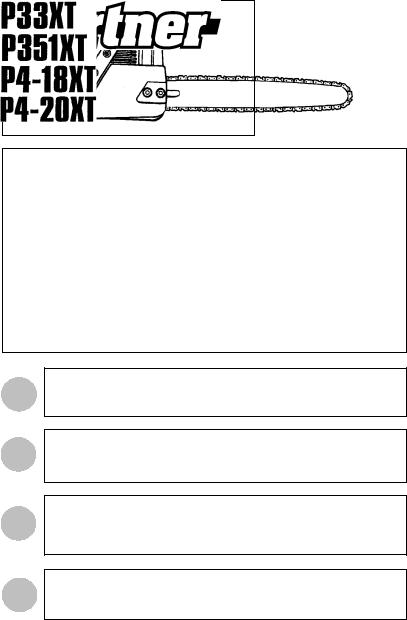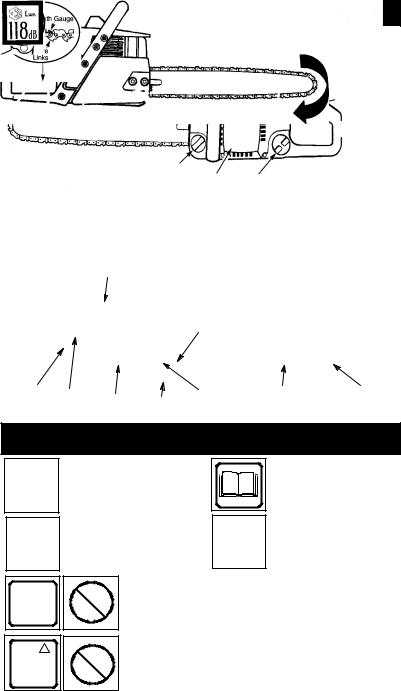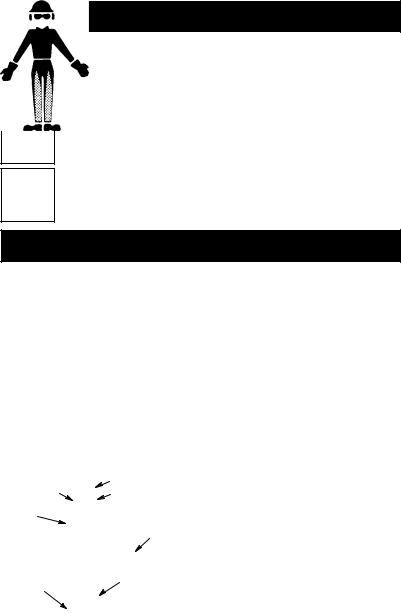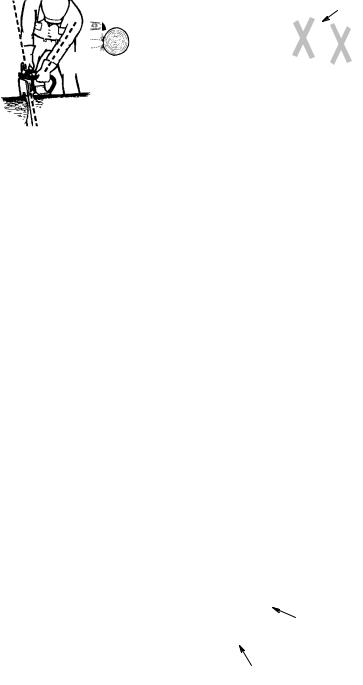Partner Tech P351XT, P4-20XT, P33XT, P4-18XT User Manual

GB
FR
DE
ES
INSTRUCTION MANUAL
IMPORTANT INFORMATION: Please read these instructions carefully and make sure you understand them before using this unit. Retain these instructions for future reference.
MANUEL D’INSTRUCTIONS
RENSEIGNEMENTS IMPORTANTS: Avant d’utiliser cet appareil, veuillez lire atentivement les instructions et assurez--vous de les avoir comprises. Conservez les instructions pour référence ultérieure.
BETRIEBSANWEISUNG
WICHTIGE INFORMATION: Lesen Sie diese Hinweise zur Handhabung des Geräts aufmerksam durch. Verwenden Sie es erst, wenn Sie sicher sind, daß Sie alle Anweisungen verstanden haben und
gut aufbewahren.
MANUAL DE INSTRUCCIONES
INFORMACIÓN IMPORTANTE: Lea atentamente las instrucciones y asegúrese de entenderlas antes de utilizar esta aparato. Conserve las instrucciones para la referencia en el futuro.
545167620 Rev. 1 9/20/07 BRW

IDENTIFICATION (WHAT IS WHAT?)
Front Hand Guard |
Front Handle |
|
Starter Rope |
|
Idle Speed Screw |
ON/STOP
Chain |
Muffler |
Switch |
Primer Bulb
|
Bar Oil |
|
|
|||
|
Fill Cap |
Starter |
Fuel Mix Fill Cap |
|||
|
|
|
|
|
||
|
|
|
|
|
Housing |
Bumper |
|
|
|
|
|
|
|
|
Bar Guard |
|
Spike |
|||
|
|
|
||||
|
Cylinder Cover |
|
|
|||
Throttle |
|
|
|
|
|
Chain |
|
|
|
|
|
||
Rear Lockout |
|
|
|
|
Adjusting |
Direction |
|
|
|
|
|||
|
|
|
|
of Travel |
||
Handle |
|
|
|
|
Screw |
|
|
|
|
|
|
||
|
|
|
|
|
|
|
Throttle |
Choke/ |
Chain |
|
Chain Brake Nuts Guide Bar |
Bar |
Trigger |
Fast Idle |
Chain |
|
Sprocket |
|
|
Lever |
Brake |
Catcher |
|
Hole |
|
|
|
|
|
IDENTIFICATION OF SYMBOLS
WARNING! This chain
saw can be dangerous! Careless or improper use can cause serious or even fatal injury.
Always wear appropriate ear protection, eye protection
and head protection.
Read and understand the instruction manual before
using the chain saw.
Sound power level
Always use two hands when operating the chain saw.
WARNING! Contacting the guide bar tip with any object
should be avoided; tip contact may cause the guide bar to move suddenly upward and backward, which may cause serious injury.
2

IDENTIFICATION OF SYMBOLS
Starting Reminder
Move ON/STOP switch to |
|
Pull the starter rope |
the ON position. |
|
sharply 5 times with your |
|
|
right hand. |
|
|
Push the choke/fast idle |
|
|
|
Slowly press primer bulb |
|
|
6 times. |
|
lever in to the HALF |
|
|
CHOKE position. |
|
|
|
|
|
|
Pull choke/fast idle lever |
|
Pull the starter rope sharply |
out to the full extent (to |
|
with your right hand until |
the FULL CHOKE posi- |
|
the engine starts. |
tion). |
|
|
SAFETY RULES
 WARNING: Always disconnect
WARNING: Always disconnect
spark plug wire and place wire where it cannot contact spark plug to prevent accidental starting when setting up, transporting, adjusting or making repairs except carburetor adjustments.
Because a chain saw is a high-speed woodcutting tool, special safety precautions must
be observed to reduce the risk of accidents. Careless or improper use of this tool can cause serious injury.
PLAN AHEAD
S Read this manual carefully until you completely understand and can follow all safety rules, precautions, and operating instructions before attempting to use the unit.
SRestrict the use of your saw to adult users who understand and can follow safety rules, precautions, and operating instructions found in this manual.
Hearing |
Safety Hat |
|
Protection |
Protection |
|
Snug |
||
Heavy Duty |
||
Fitting |
||
Clothing |
Gloves |
|
|
Chaps |
SWear protective gear. Always use steel-toed safety footwear with non-slip soles; snug-fit- ting clothing; heavy-duty, non-slip gloves; eye protection such as non-fogging, vented goggles or face screen; an approved safety hard hat; and sound barriers (ear plugs or mufflers) to protect your hearing. Secure hair above shoulder length.
SAlways use approved hearing protection. Regular users should have hearing checked regularly as chain saw noise can damage
hearing. Long--term exposure to noise can result in permanent hearing impairment.
SKeep all parts of your body away from the chain when the engine is running.
S Keep children, bystanders, and animals a minimum of 10 Meters away from the work area. Do not allow other people or animals to be near the chain saw when starting or operating the chain saw.
SDo not handle or operate a chain saw when you are fatigued, ill, or upset, or if you have taken alcohol, drugs, or medication. You must be in good physical condition and mentally alert. Chain saw work is strenuous. If you have any condition that might be aggra-
vated by strenuous work, check with your doctor before operating a chain saw.
SCarefully plan your sawing operation in advance. Do not start cutting until you have a clear work area, secure footing, and, if you are felling trees, a planned retreat path.
OPERATE YOUR SAW SAFELY
 WARNING: Long term inhalation of
WARNING: Long term inhalation of
the engine’s exhaust fumes, chain oil mist and dust from sawdust can result in serious personal injury.
SDo not operate a chain saw with one hand. Serious injury to the operator, helpers, bystanders or any combination of these per-
sons may result from one-handed operation. A chain saw is intended for two-handed use.
SOperate the chain saw only in a well-venti- lated outdoor area.
S Do not operate saw from a ladder or in a tree, unless you are specifically trained to do so.
SMake sure the chain will not make contact with any object while starting the engine. Never try to start the saw when the guide bar is in a cut.
3
SDo not put pressure on the saw at the end of the cut. Applying pressure can cause you to
lose control when the cut is completed.
S Stop the engine before setting the saw down.
SDo not operate a chain saw that is damaged, improperly adjusted, or not completely and securely assembled. Always replace bar, chain, hand guard, or chain
brake immediately if it becomes damaged, broken or is otherwise removed.
SWith the engine stopped, hand carry the chain saw with the muffler away from your body, and the guide bar and chain to the rear, preferably covered with a scabbard.
CHAIN SAW SAFETY EQUIPMENT
NOTE: In this section, the safety features of
the chain saw and their function are explained. For inspection and maintenance, see instructions in the CHECKING, MAINTAINING AND
SERVICING CHAIN SAW SAFETY EQUIPMENT section. See instructions under the WHAT IS WHAT? section, to find where these parts are located on your chain saw. The life span of the machine can be reduced and the risk of accidents can increase if machine maintenance is not carried out correctly and if service and/or repairs are not carried out professionally. If you need further information, please contact your nearest service dealer.
SChain brake. Your chain saw is equipped with a chain brake that is designed to stop the chain from moving.
 WARNING: The chain brake is de-
WARNING: The chain brake is de-
signed to stop the chain immediately if you get a kickback. The chain brake reduces the risk of accidents, but only you can prevent them. DO NOT ASSUME THAT THE CHAIN BRAKE WILL PROTECT YOU IN THE EVENT OF A KICKBACK.
SThrottle trigger lock-out. The throttle lock--out is designed to prevent accidental
operation of the throttle trigger.
SChain catcher. The chain catcher is designed to catch the saw chain if it breaks.
SVibration damping system. Your chain saw is equipped with a vibration damping system that is designed to minimize vibration and make operation easier.
SAFETY NOTICE: Exposure to vibrations
through prolonged use of gasoline powered hand tools could cause blood vessel or nerve damage in the fingers, hands, and joints of people prone to circulation disorders or abnormal
swellings. Prolonged use in cold weather has been linked to blood vessel damage in otherwise healthy people. If symptoms occur such as numbness, pain, loss of strength, change in skin color or texture, or loss of feeling in the fingers, hands, or joints, discontinue the use of this tool and seek medical attention. An antivibration system does not guarantee the avoidance of these problems. Users who operate power tools on a continual and regular basis
must monitor closely their physical condition and the condition of this tool.
SON/STOP switch. The ON/STOP switch should be used to stop the engine.
CHECKING, MAINTAINING AND
SERVICING CHAIN SAW SAFETY EQUIPMENT
 WARNING: Never use a chain saw
WARNING: Never use a chain saw
with defective safety equipment. Safety equipment must be inspected and main-
tained. If your chain saw does not pass inspection, take the saw to your nearest service dealer for repair.
S Chain brake. Brush off any wood dust, resin and dirt from the chain brake and clutch drum. Dirt and wear can impair operation of the brake. For additional information, see OPERATING YOUR UNIT section.
SThrottle trigger lock-out. Check that the throttle trigger can not be operated until the
throttle lock--out is pressed.
S Chain catcher. Check that the chain catcher is not damaged and is firmly attached to the body of the chain saw.
S Vibration damping system. Regularly check the vibration damping units for cracks or deformation. Make sure the vibration damping units are securely attached to the engine unit and handle unit.
S ON/STOP switch. Start the engine and make sure the engine stops when you move the ON/STOP switch to the STOP position.
MAINTAIN YOUR SAW IN GOOD WORKING ORDER
SHave all chain saw service performed by a qualified service dealer with the exception of the items listed in the maintenance section of this manual. For example, if improper tools are used to remove or hold the flywheel when servicing the clutch, structural
damage to the flywheel can occur and cause the flywheel to burst.
SMake certain the saw chain stops moving when the throttle trigger is released. For correction, refer to CARBURETOR AD-
JUSTMENTS.
S Never modify your saw in any way. Use only attachments supplied or specifically recommended by the manufacturer.
S Keep the handles dry, clean, and free of oil or fuel mixture.
S Keep fuel and oil caps, screws, and fasteners securely tightened.
S Use only Partner accessories and replacement parts as recommended.
HANDLE FUEL WITH CAUTION
S Do not smoke while handling fuel or while operating the saw.
SEliminate all sources of sparks or flame in the areas where fuel is mixed or poured. There should be no smoking, open flames, or work that could cause sparks. Allow en-
gine to cool before refueling.
SMix and pour fuel in an outdoor area on bare ground; store fuel in a cool, dry, well ventilated place; and use an approved, marked container for all fuel purposes. Wipe up all fuel spills before starting saw.
SMove at least 10 feet (3 meters) from fueling site before starting engine.
4

STurn the engine off and let saw cool in a non-combustible area, not on dry leaves,
straw, paper, etc. Slowly remove fuel cap and refuel unit.
SStore the unit and fuel in an area where fuel vapors cannot reach sparks or open flames from water heaters, electric motors or switches, furnaces, etc.
KICKBACK
 WARNING: Avoid kickback which
WARNING: Avoid kickback which
can result in serious injury. Kickback is the backward, upward or sudden forward motion of the guide bar occurring when the saw chain near the upper tip of the guide bar contacts any object such as a log or branch, or when the wood closes in and pinches the saw chain in the cut. Contacting a foreign object in the wood can also result in loss of chain saw control.
SRotational Kickback can occur when the moving chain contacts an object at the upper tip of the guide bar. This contact can cause the chain to dig into the object, which stops the chain for an instant. The result is a lightning fast, reverse reaction which kicks the guide bar up and back toward the operator.
SPinch-Kickback can occur when the the wood closes in and pinches the moving saw chain in the cut along the top of the guide bar and the saw chain is suddenly stopped. This sudden stopping of the chain results in a reversal of the chain force used to cut wood and causes the saw to move in the opposite direction of the chain rotation. The saw is driven straight back toward the operator.
SPull-In can occur when the moving chain contacts a foreign object in the wood in the cut along the bottom of the guide bar and the saw chain is suddenly stopped. This sudden stopping pulls the saw forward and away from the operator and could easily cause the operator to lose control of the saw.
Avoid Pinch-Kickback:
S Be extremely aware of situations or obstructions that can cause material to pinch the top of or otherwise stop the chain.
S Do not cut more than one log at a time.
SDo not twist the saw as the bar is withdrawn from an undercut when bucking.
Avoid Pull-In:
S Always begin cutting with the engine at full speed and the saw housing against wood.
S Use wedges made of plastic or wood. Never use metal to hold the cut open.
Kickback Path
Clear the working area
REDUCE THE CHANCE OF KICKBACK
S Recognize that kickback can happen. With a basic understanding of kickback,
you can reduce the element of surprise which contributes to accidents.
SNever let the moving chain contact any object at the tip of the guide bar.
SKeep the working area free from obstructions such as other trees, branches, rocks, fences, stumps, etc. Eliminate or avoid any obstruction that your saw chain could hit while you are cutting through a particu-
lar log or branch.
SKeep your saw chain sharp and properly tensioned. A loose or dull chain can increase the chance of kickback occurring. Follow manufacturer’s chain sharpening and maintenance instructions. Check tension at regular intervals with the engine stopped, never with the engine running. Make sure the bar clamp nuts are securely tightened after tensioning the chain.
S Begin and continue cutting at full speed. If the chain is moving at a slower speed, there is greater chance of kickback occurring.
S Cut one log at a time.
S Use extreme caution when re-entering a previous cut.
SDo not attempt cuts starting with the tip of the bar (plunge cuts).
S Watch for shifting logs or other forces that could close a cut and pinch or fall into chain.
SUse the Reduced--Kickback Guide Bar and Low--Kickback Chain specified for your saw.
MAINTAIN CONTROL
Stand to the left the saw
Never reverse hand positions
 Elbow locked
Elbow locked
 Thumb on underside of handlebar
Thumb on underside of handlebar
5
